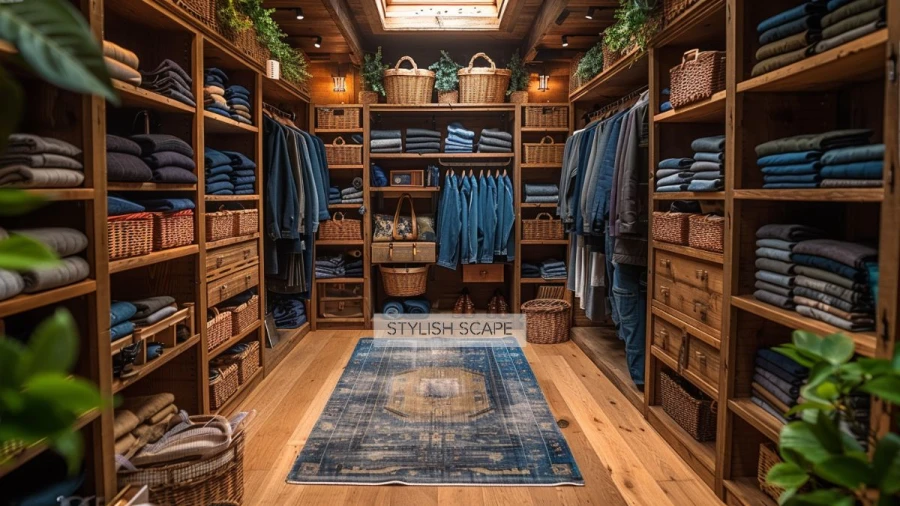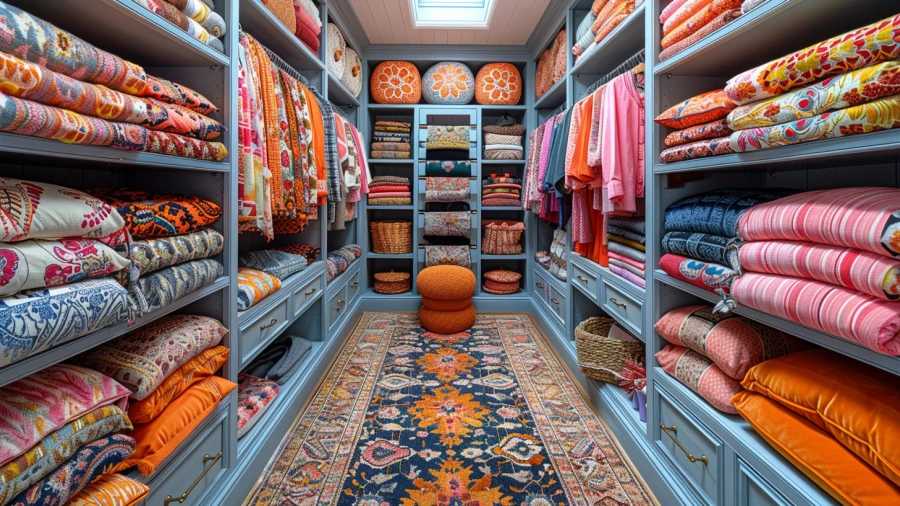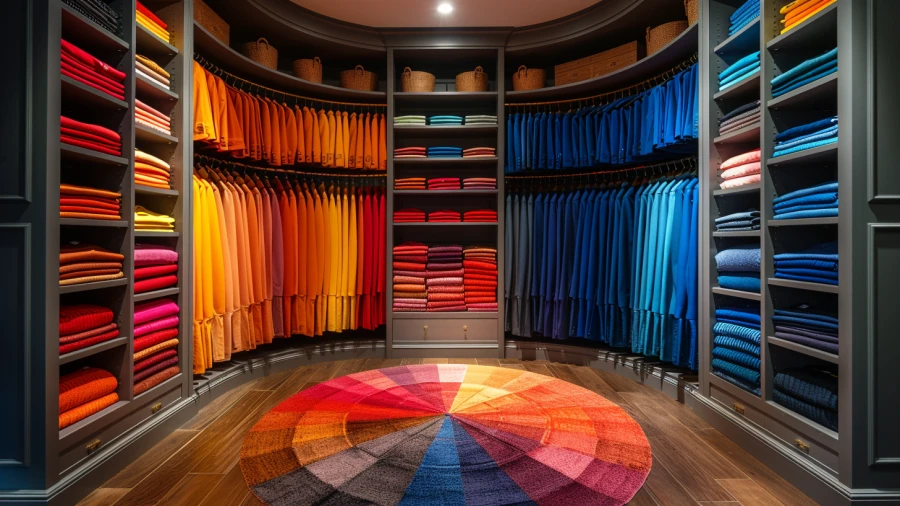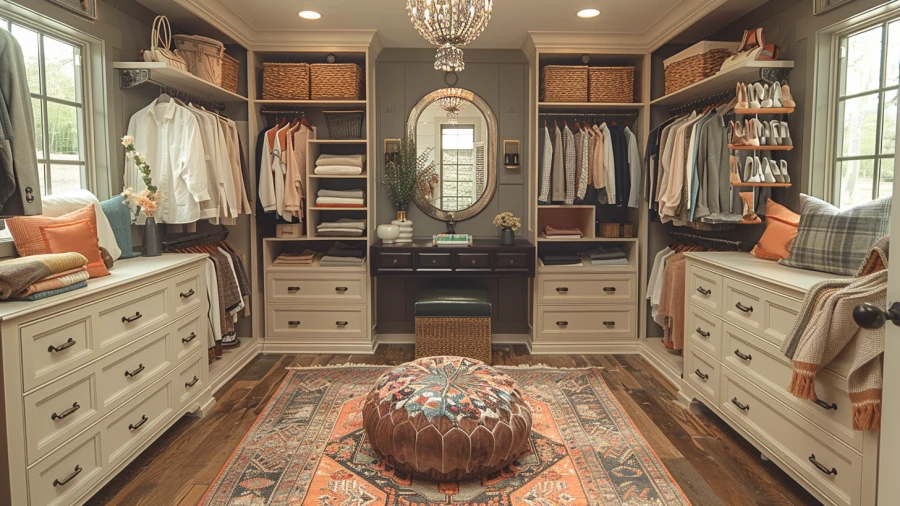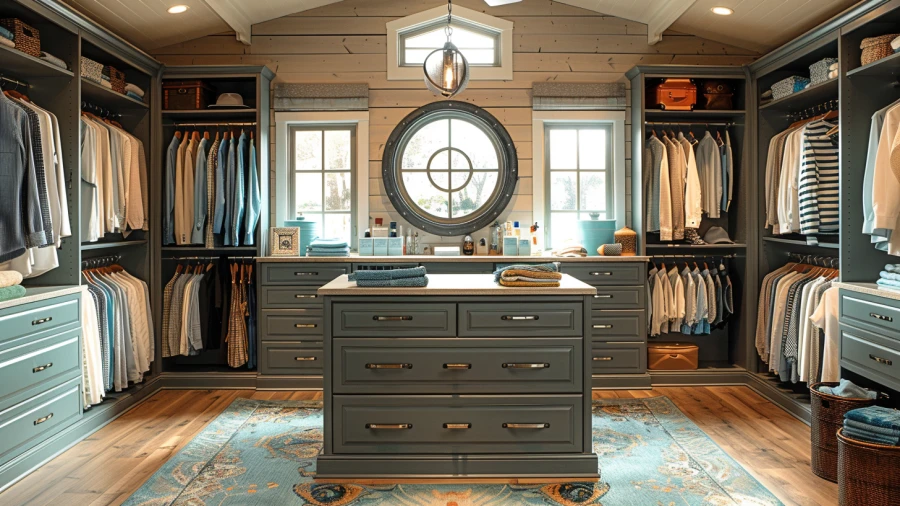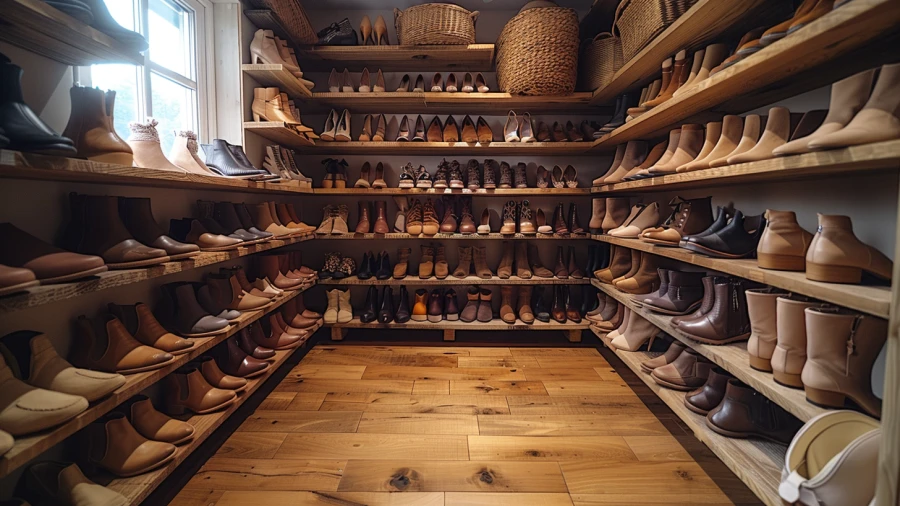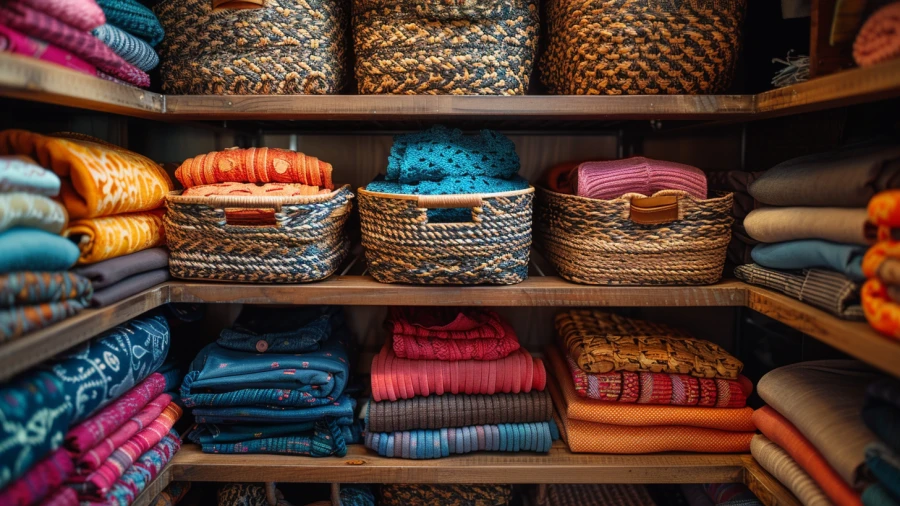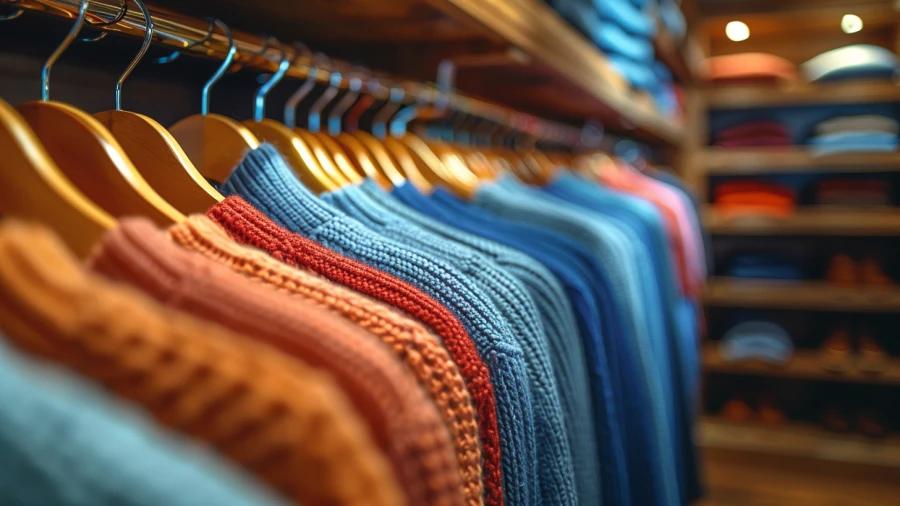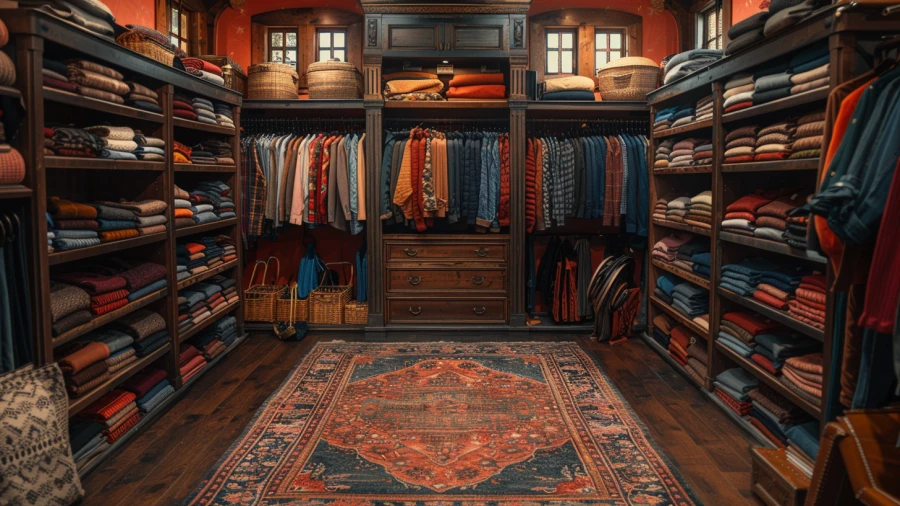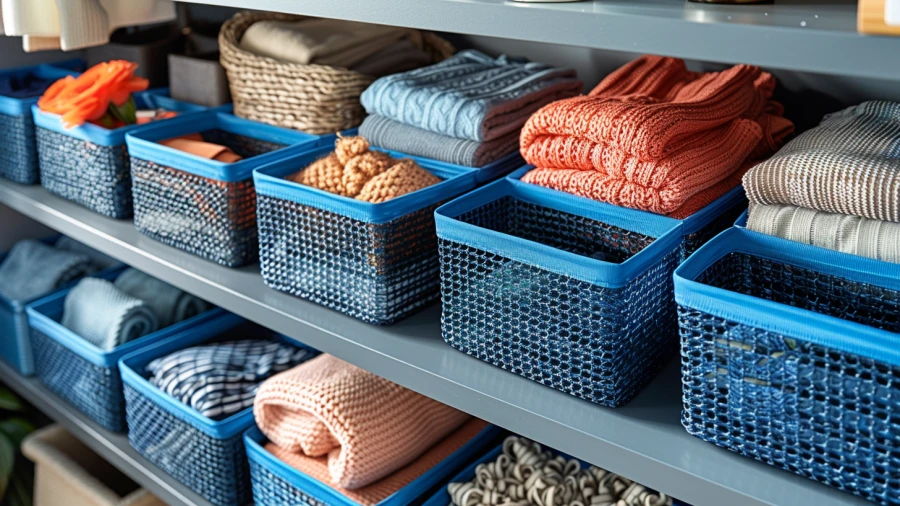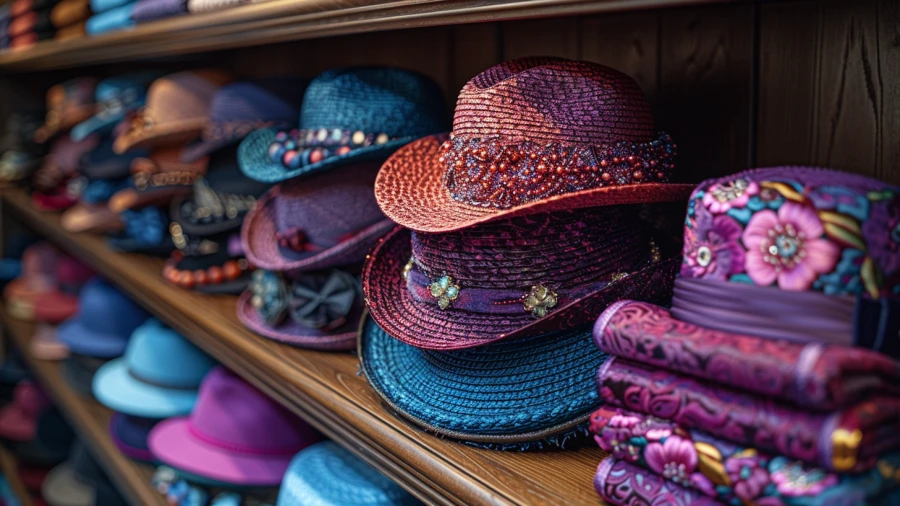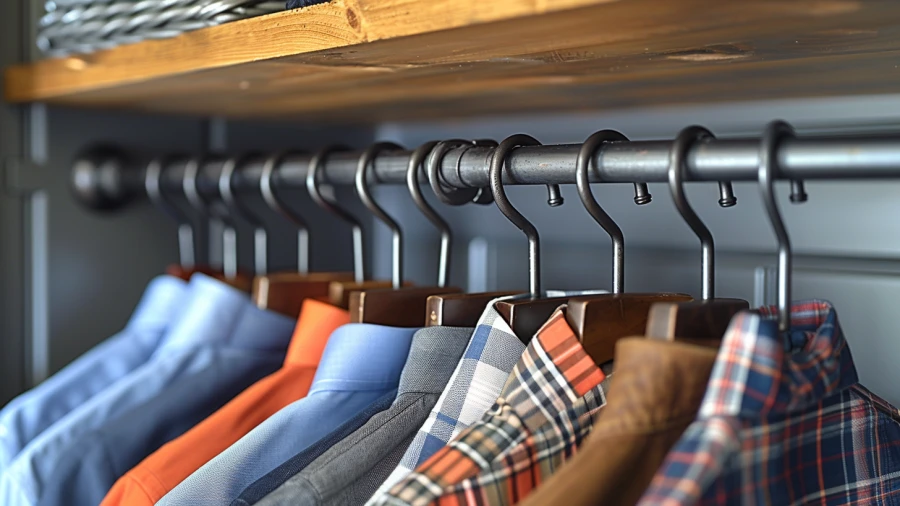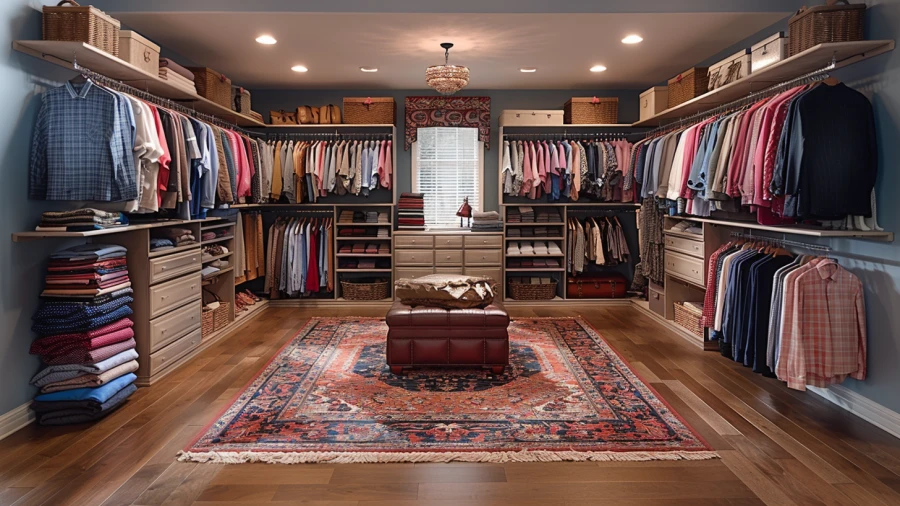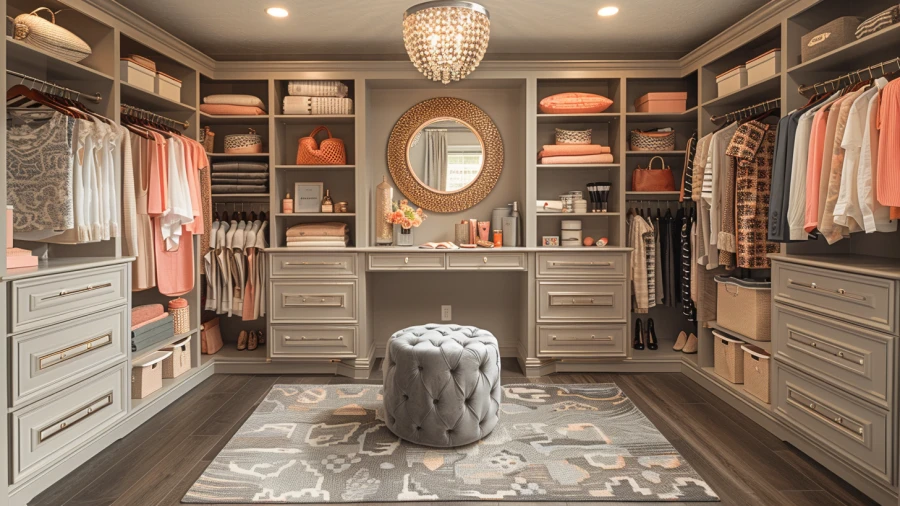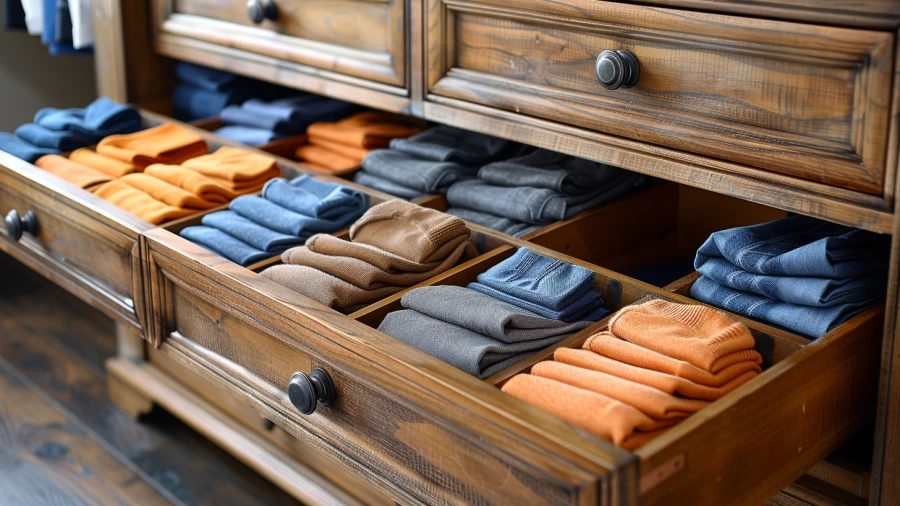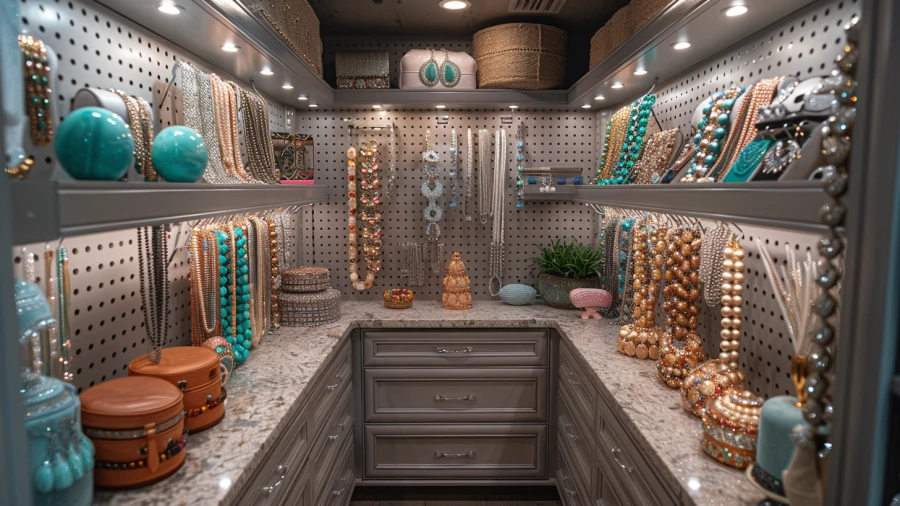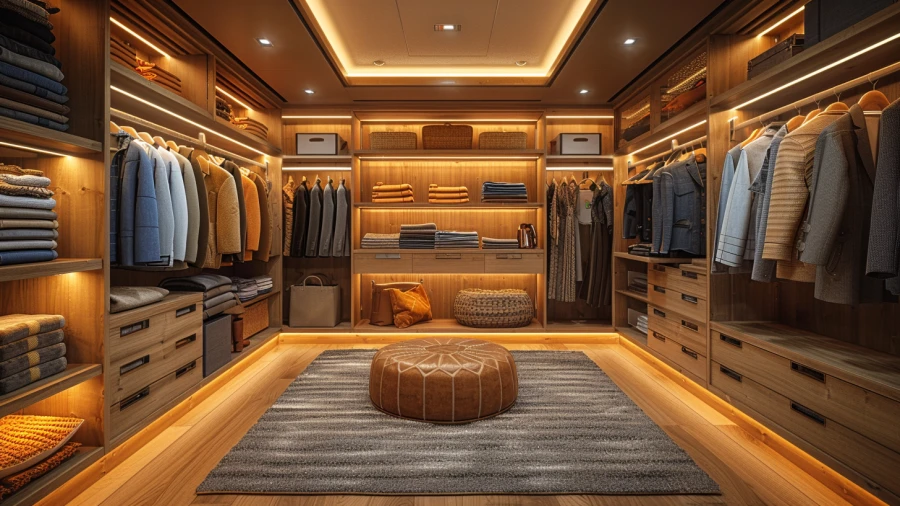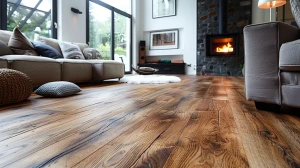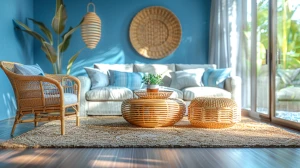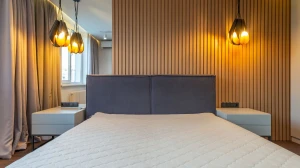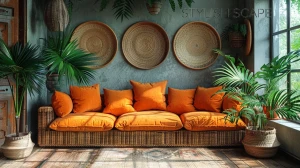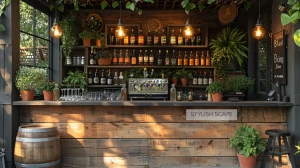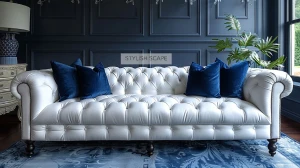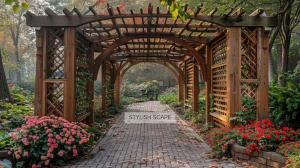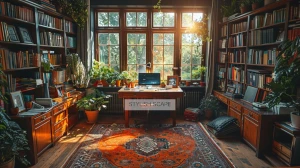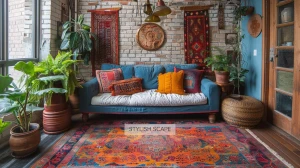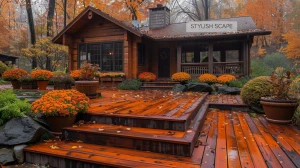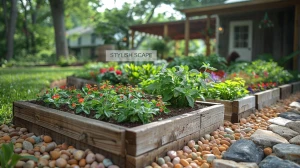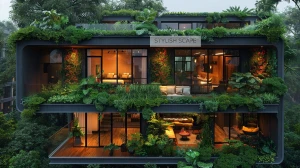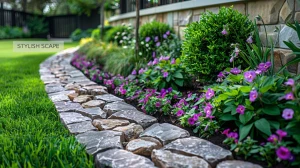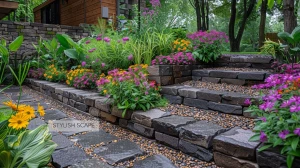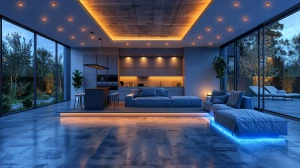
Top 20 Walk-in Closet Ideas for a Stylish and Organized Space
Explore creative Walk-in Closet Ideas to transform your space into a stylish, organized haven. From custom shelving and good lighting to smart storage solutions, these Walk-in Closet Ideas will help you maximize space and effortlessly enhance your daily routine.
by B Kishwar
Updated Jul 27, 2024
On This Page
- Walk-in Closet Ideas
- Accentuate Walls With Wallpaper or Fabric
- Group Items by Category
- Let Color Be Your Guide
- Divide the Space by User
- Incorporate Freestanding Furniture
- Install an Island
- Store Shoes Off the Floor
- Use Bins, Baskets, and Labels
- Invest in Matching Hangers
- Consider Seasonal Storage
- Use Matching Bins for Smaller Items
- Showcase Your Accessories
- Install a Valet Hook
- Choose Locations Based on Your Routine
- Add a Vanity
- Store Clothes Vertically in Drawers
- Allow Space for Laundry and Trash
- Make a Jewelry Wall
- Invest in Good Quality Lighting
- Opt for Custom Solutions
- How Do I Choose the Right Lighting for a Walk-in Closet?
- What Are the Best Ways to Organize a Walk-in Closet?
Walk-in Closet Ideas
A walk-in closet is a luxurious and functional addition to any home, providing ample space for clothes, shoes, and accessories. To maximize its potential, consider organizing items by category and color. Use matching hangers for a tidy look, and install shelves or cubbies to keep shoes off the floor. Add bins and labels for small items like socks and scarves.
A vanity or island can enhance functionality, while good lighting makes everything easy to see. Custom solutions tailored to your needs can transform the closet into an organized, stylish space that simplifies your daily routine.
Accentuate Walls With Wallpaper or Fabric
Adding wallpaper or fabric to the walls of your walk-in closet can infuse the space with personality and style. Choose patterns or colors that reflect your taste, transforming the closet into a creative haven where you can assemble outfits each day. Wallpaper or fabric can also add texture and warmth, making the space feel cozy and inviting.
Consider lining the inside of shelving units or the back of open cabinets for a subtle yet impactful design element. This customization not only enhances aesthetics but also makes the closet feel more personalized and unique, turning it into a delightful area where you’ll enjoy spending time.
Group Items by Category
Organizing your walk-in closet by grouping items by category makes getting dressed faster and more efficient. Hang shirts with shirts, sweaters with sweaters, and so on, to streamline the process of finding what you need. For added organization, you can sub-categorize within these groups by color, sleeve length, or occasion.
This method not only saves time but also keeps your closet looking neat and tidy. Knowing exactly where each item belongs reduces clutter and makes it easier to maintain order, ensuring that your walk-in closet remains a functional and stress-free space.
Let Color Be Your Guide
Using color to organize your walk-in closet adds a pleasing aesthetic and makes it easier to find items. Group clothing by color, starting with neutrals like black, white, and gray, and then moving through the spectrum of colors. This method creates a visually harmonious space and helps you quickly locate garments based on their hue.
Separating bright colors with neutral shades can prevent clashing and create a balanced look. Color coordination also allows you to see what colors you have more of, helping you make better shopping decisions and ensuring your wardrobe is well-rounded.
Divide the Space by User
In a shared walk-in closet, dividing the space by user ensures that everyone has their own dedicated area for their belongings. Allocate sections based on the amount of clothing and accessories each person has, which may not always be equal. This division can be marked by different shelving units, hanging rods, or even labeled sections.
Personalized storage solutions cater to each user’s needs, making the closet more functional and organized. This method prevents mix-ups and helps each person maintain their own space, contributing to a harmonious and efficient shared closet environment.
Incorporate Freestanding Furniture
Adding freestanding furniture to your walk-in closet can elevate its style and functionality. Items like an antique mirrored vanity or a stylish floor mirror can add character and provide practical benefits. Freestanding drawers or cabinets offer additional storage without the need for built-in installations, making them ideal for organizing accessories, shoes, or folded clothes.
A comfortable chair or a small bench can create a cozy spot for dressing or trying on shoes. This approach allows for flexibility in design and layout, enabling you to tailor the space to your specific needs and preferences while adding unique elements to the decor.
Install an Island
Installing an island in your walk-in closet can greatly enhance its functionality and storage capacity. Choose an island with a combination of drawers and open shelves to store accessories, folded clothes, and shoes. The top surface can be used for folding clothes, organizing outfits, or displaying items like jewelry and handbags.
An island provides a central workspace, making it easier to sort and manage your wardrobe. Additionally, it can add a touch of luxury and sophistication to the closet. If space allows, this feature transforms the closet into a more organized and efficient area, helping you maintain a clutter-free environment.
Store Shoes Off the Floor
Storing shoes off the floor not only makes your walk-in closet look neater but also prolongs the life of your footwear. Use shelves, cubbies, or shoe racks to keep shoes organized and easily accessible. Arrange them by style and color for a boutique-like display. Vertical storage solutions maximize space and keep shoes visible, so you can quickly find the pair you need.
Flat shelves are preferable as they prevent shoes from sliding off. This method keeps the floor clear, reduces clutter, and ensures that your shoes remain in good condition, making the overall space more functional and visually appealing.
Use Bins, Baskets, and Labels
Incorporating bins, baskets, and labels in your walk-in closet is a simple yet effective way to maintain order and organization. Store items that don’t need to be hung, such as scarves, belts, and accessories, in labeled bins or baskets. This method creates specific homes for each category, making it easier to find and return items.
Labels help maintain the system by clearly indicating where everything belongs, reducing the chances of clutter. Matching bins or baskets can enhance the aesthetic appeal of the closet, creating a cohesive and tidy look. This approach ensures that every item has a designated place, simplifying daily routines.
Invest in Matching Hangers
Investing in matching hangers can instantly upgrade the look and feel of your walk-in closet. Uniform hangers create a cohesive and organized appearance, making the space look tidy and well-maintained. They also help prevent clothes from slipping or getting misshapen, preserving their condition. Choose hangers that suit your wardrobe needs, such as padded hangers for delicate items, wooden hangers for heavier garments, and slim, non-slip hangers for maximizing space.
Matching hangers streamline the visual flow of the closet, making it easier to scan and select outfits. This small investment has a big impact on the overall functionality and aesthetic of your closet.
Consider Seasonal Storage
Implementing seasonal storage in your walk-in closet will help you keep your apparel tidy and maximize available space. Store off-season clothing in labeled containers or boxes on higher shelves to make a place for current-season products that are easily accessible. Rotate your clothing every season, taking down stored goods and storing those you won't need for a while.
This method not only lowers clutter but also keeps your closet functional and easy to use throughout the year. Seasonal storage keeps you organized, making it easier to find and use the clothes you need when you need them.
Use Matching Bins for Smaller Items
Using matching bins for smaller items in your walk-in closet helps maintain a clean and organized appearance. Store items like socks, scarves, belts, and other accessories in these bins to keep them from cluttering shelves or drawers. Matching bins create a cohesive look, enhancing the aesthetic appeal of the closet. Label each bin to easily identify its contents, ensuring that everything has a designated place.
This method makes it easier to find and return items, reducing clutter and maintaining order. Opt for bins in materials and colors that complement your closet design, blending functionality with style to create an organized and visually pleasing space.
Showcase Your Accessories
Showcasing your accessories in your walk-in closet not only makes them easy to find but also adds a touch of elegance to the space. Use hooks, display trays, or open shelves to feature items like jewelry, handbags, and hats. Organizing accessories by type and color can create a visually appealing display that resembles a boutique.
This method not only keeps your accessories organized but also makes it simple to see all your options at a glance, helping you coordinate outfits effortlessly. Highlighting your favorite pieces adds personality to the closet and transforms it into a space that reflects your style.
Install a Valet Hook
Installing a valet hook in your walk-in closet provides both convenience and usefulness. A valet hook gives a temporary place to hang things that you intend to wear, try on, or pack for a trip. It is also excellent for storing objects that need to be dry cleaned or repaired. This simple improvement keeps the closet orderly and clothing from ending placed on the floor or over a chair.
To expedite your dressing process and keep the space tidy, place the hook in a convenient spot, such as near the entryway or next to a mirror.
Choose Locations Based on Your Routine
Organizing your walk-in closet based on your daily routine can make getting dressed more efficient and enjoyable. Consider how you typically get dressed and arrange items accordingly. Place frequently used items like underwear, socks, and everyday clothes within easy reach. Store less frequently used items, such as formal wear or seasonal clothes, on higher shelves or in less accessible areas.
Keep accessories like jewelry and belts near the mirror for easy access when finalizing outfits. By tailoring the layout to your routine, you create a logical flow that simplifies your daily tasks and ensures that everything is conveniently located.
Add a Vanity
Adding a vanity to your walk-in closet transforms it into a luxurious and multifunctional space. A vanity provides a dedicated area for applying makeup, styling hair, and getting ready, making your morning routine more efficient. Choose a vanity with ample storage for beauty products, brushes, and other essentials. A well-lit mirror, comfortable stool, and stylish design can enhance the overall aesthetic of the closet.
Personalize the vanity with decorative items, such as a vase of flowers or a framed photo, to make it feel special. This addition not only adds functionality but also creates a serene and enjoyable space for your daily grooming rituals.
Store Clothes Vertically in Drawers
Storing clothes vertically in drawers saves room and allows you to see all of your belongings at a glance. Fold and arrange items such as t-shirts, sweaters, and jeans upright, just like files in a filing cabinet. This strategy keeps garments from getting buried and forgotten in the bottom of the drawer. Using drawer dividers keeps stuff orderly and in place.
Vertical storage not only enhances visibility, but it also makes it easier to keep things organized because each item has its own space. This strategy is especially effective for small closets since it maximizes drawer space and improves accessibility.
Allow Space for Laundry and Trash
Designating space for laundry and trash in your walk-in closet ensures that the area remains clean and organized. Include a laundry hamper or basket for dirty clothes, making it easy to separate worn items from clean ones. Consider adding a small trash bin for discarded tags, lint roller sheets, and other waste.
Keeping these containers within the closet prevents clutter from accumulating on the floor or other surfaces. This setup promotes a tidy environment and streamlines your daily routine, as you can quickly dispose of trash and collect laundry without leaving the closet, maintaining a neat and functional space.
Make a Jewelry Wall
Creating a jewelry wall in your walk-in closet adds both functionality and a touch of elegance. Install hooks, pegboards, or specialized jewelry organizers on a section of the wall to display necklaces, bracelets, earrings, and other accessories. This arrangement keeps jewelry untangled and easily accessible, making it simple to select pieces that complement your outfit.
A jewelry wall also serves as a decorative element, showcasing your collection like art. By keeping your jewelry visible and organized, you’ll be more likely to wear a variety of pieces, enhancing your overall style and making the closet a more personalized and visually appealing space.
Invest in Good Quality Lighting
Investing in good-quality lighting is essential for making your walk-in closet both functional and inviting. Adequate lighting ensures that you can see all your clothing and accessories clearly, making it easier to choose outfits and spot any imperfections. Consider a combination of overhead lights, task lighting, and accent lighting to create a well-lit space.
LED lights are a great option for their brightness and energy efficiency. Install lights inside cabinets or under shelves to illuminate dark areas. Good lighting not only enhances visibility but also highlights the closet’s design features, creating a bright and welcoming environment.
Opt for Custom Solutions
Opting for custom solutions in your walk-in closet tailors the space to your specific needs and preferences. Custom shelving, drawers, and hanging systems maximize storage and ensure that every item has its own place. Work with a designer to create a layout that accommodates your wardrobe, including special features like a shoe wall, accessory drawers, or a built-in vanity.
Custom solutions allow you to choose materials, finishes, and configurations that match your style and enhance the closet’s functionality. This personalized approach transforms the closet into an efficient and aesthetically pleasing space, making it easier to maintain order and enjoy your wardrobe.
How Do I Choose the Right Lighting for a Walk-in Closet?
To choose the right lighting for a walk-in closet:
- Combine Light Sources: Use a mix of overhead lights, task lighting, and accent lighting. Overhead lights provide general illumination, task lighting helps you see details, and accent lighting highlights features.
- Opt for LED Bulbs: LED lights are bright, energy-efficient, and long-lasting. They also offer good color accuracy, helping you see true colors of your clothing.
- Install Dimmer Switches: Dimmer switches allow you to adjust the brightness according to your needs, from bright light for dressing to softer light for a relaxed ambiance.
- Use Under-Shelf Lighting: Install lights under shelves to illuminate darker areas and make items easier to find.
- Consider Recessed Lighting: Recessed lights can be installed in the ceiling for a clean, unobtrusive look that evenly distributes light.
What Are the Best Ways to Organize a Walk-in Closet?
To organize a walk-in closet effectively:
- Sort by Category: Group clothes by type—shirts, pants, jackets—so you can find what you need easily.
- Use Matching Hangers: Choose uniform hangers for a tidy, cohesive look and to prevent clothes from slipping.
- Install Shelving and Cubbies: Add shelves and cubbies for shoes, accessories, and folded items to keep everything accessible.
- Utilize Bins and Baskets: Store small items like scarves and belts in labeled bins or baskets to avoid clutter.
- Designate Zones: Create specific areas for different functions, such as a section for everyday wear and another for special occasions.
- Add Drawer Dividers: Use dividers in drawers to keep items like socks and underwear neatly separated.
- Rotate Seasonal Items: Store off-season clothes in bins or higher shelves to keep current items easily accessible.
